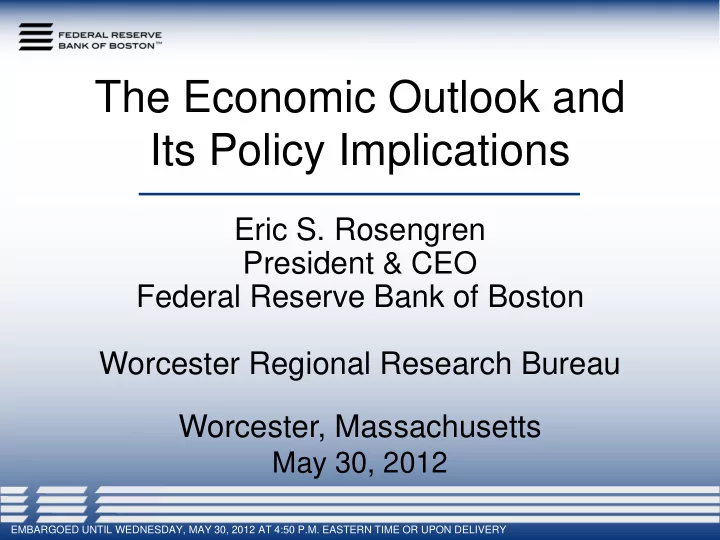

The Economic Outlook and Its Policy Implications Eric S. Rosengren President & CEO Federal Reserve Bank of Boston Worcester Regional Research Bureau Worcester, Massachusetts May 30, 2012 EMBARGOED UNTIL WEDNESDAY, MAY 30, 2012 AT 4:50 P.M. EASTERN TIME OR UPON DELIVERY
Overview Only modest growth expected: 2-2.5 percent for 2012 Assumes Europe is able to “muddle through” Assumes fiscal compromise that avoids a “fiscal cliff” (expiration of Bush tax cut, payroll tax cut, AMT revisions, unemployment benefits, along with sequestration) Implies little improvement in labor markets 2
Figure 1 Growth in Real GDP Components: Consumption and Residential Investment 2011:Q2 - 2012:Q1 ResidentialInvestment Consumption Percent Change at Annual Rate Percent Change at Annual Rate 4 20 3 15 2 10 1 5 0 0 -1 -5 2011:Q2 2011:Q3 2011:Q4 2012:Q1 2011:Q2 2011:Q3 2011:Q4 2012:Q1 Source: Bureau of Economic Analysis / Haver Analytics 3
Figure 2 Growth in Real House Prices by Census Region* 1984:Q1 - 2012:Q1 Percent Change from Year Earlier 30 20 10 0 -10 -20 NE MA ENC WNC SA ESC WSC M P -30 1984:Q1 1988:Q1 1992:Q1 1996:Q1 2000:Q1 2004:Q1 2008:Q1 2012:Q1 * The 9 census regions are: New England (NE), Middle Atlantic (MA), East North Central (ENC), West North Central (WNC), South Atlantic (SA), East South Central (ESC), West South Central (WSC), Mountain (M) and Pacific (P). Source: Federal Housing Finance Agency / Haver Analytics 4
Figure 3 Growth in Real GDP Components: Government Spending and Business Investment 2011:Q2 - 2012:Q1 GovernmentSpending Business Investment Percent Change at Annual Rate Percent Change at Annual Rate 5.0 20 15 2.5 10 0.0 5 -2.5 0 -5.0 -5 2011:Q2 2011:Q3 2011:Q4 2012:Q1 2011:Q2 2011:Q3 2011:Q4 2012:Q1 Source: Bureau of Economic Analysis / Haver Analytics 5
Figure 4 Estimates of Real GDP Growth 2010:Q1 - 2012:Q1 Percent Change at Annual Rate 4.0 3.0 2.0 Advance Estimate 1.0 Second Estimate Third Estimate Revised Estimate 0.0 2010:Q1 2010:Q3 2011:Q1 2011:Q3 2012:Q1 Source: Bureau of Economic Analysis 6
Figure 5 Economic Projections of FOMC Participants and the Federal Reserve Bank of Boston, April 2012 FOMC Central Federal Reserve Tendency Bank of Boston Variable (Percent) (Percent) Unemployment Rate 7.8 to 8.0 8.1 (2012:Q4) Real GDP Growth 2.4 to 2.9 2.3 (2011:Q4 – 2012:Q4) PCE Inflation 1.9 to 2.0 1.7 (2011:Q4 – 2012:Q4) Core PCE Inflation 1.8 to 2.0 1.7 (2011:Q4 – 2012:Q4) Note: The central tendency excludes the three highest and three lowest projections for each variable. Source: Federal Reserve Board, Federal Reserve Bank of Boston 7
Summary Downside risks restrain current growth Monetary policy should remain accommodative to promote faster growth and lower unemployment Further accommodation is both appropriate and necessary 8
Can Policy Address High Unemployment? Some structural unemployment – mismatch in skills occurs during most recessions/ recoveries Cyclical factors still the most important source of high unemployment Want to avoid a cyclical problem becoming a structural problem 9
Figure 6 Employment Growth by Census Region* 1980:Q1 - 2012:Q1 Percent Change from Year Earlier 8 6 4 2 0 -2 -4 -6 NE MA ENC WNC SA ESC WSC M P -8 1980:Q1 1984:Q1 1988:Q1 1992:Q1 1996:Q1 2000:Q1 2004:Q1 2008:Q1 2012:Q1 * The 9 census regions are: New England (NE), Middle Atlantic (MA), East North Central (ENC), West North Central (WNC), South Atlantic (SA), East South Central (ESC), West South Central (WSC), Mountain (M) and Pacific (P). Source: Bureau of Labor Statistics / Haver Analytics 10
Figure 7 Unemployment Rate by Census Region December 2007 and April 2012 Percent 12 December 2007 April 2012 10 8 6 4 2 0 New Middle East West South East West Mountain Pacific United England Atlantic North North Atlantic South South States Central Central Central Central Source: Bureau of Labor Statistics / Haver Analytics 11
Figure 8 Employment Change from Peak Employment Most Recent and Three Previous Peaks Percent Change from Peak Employment 1 0 -1 -2 -3 July 1981 -4 June 1990 -5 February 2001 -6 January 2008 -7 -32 -28 -24 -20 -16 -12 -8 -4 0 4 8 12 16 20 24 28 Months Before and After Employment Trough Source: Bureau of Labor Statistics / Haver Analytics 12
Figure 9 Employment Change from Peak Employment: Total and Total Excluding Construction and Government Most Recent Peak Percent Change from Peak Employment 1 0 January 2008 - Total Employment -1 January 2008 - Total Employment Excluding Construction and Government -2 -3 -4 -5 -6 -7 -32 -28 -24 -20 -16 -12 -8 -4 0 4 8 12 16 20 24 28 Months Before and After Employment Trough Note: Both series use peak and trough of total employment series. Source: Bureau of Labor Statistics / Haver Analytics 13
Figure 10 Employment Growth by Industry 1980:Q1 - 2012:Q1 Percent Change from Year Earlier Construction 15 Manufacturing 10 Trade, Transportation and Utilities 5 Information 0 Financial Activities -5 Professional and Business Services Education and Health -10 Services Leisure and Hospitality -15 Other Services -20 Government 1980:Q1 1986:Q1 1992:Q1 1998:Q1 2004:Q1 2010:Q1 Source: Bureau of Labor Statistics / Haver Analytics 14
Figure 11 Employment Cost Index for Wages and Salaries by Industry 2002:Q1 - 2012:Q1 Percent Change from Year Earlier Construction 7 Manufacturing 6 Trade, Transportation 5 and Utilities Information 4 Financial Activities 3 Professional and Business Services 2 Education and Health Services 1 Leisure and Hospitality 0 Other Services -1 State and Local 2002:Q1 2004:Q1 2006:Q1 2008:Q1 2010:Q1 2012:Q1 Government Source: Bureau of Labor Statistics / Haver Analytics 15
Conclusion Unemployment is uncomfortably high and PCE inflation is likely to be below 2 percent Significant downside risks Monetary policy should be more stimulative to address inadequate demand Should downside risks materialize, more aggressive policy certainly warranted 16
Recommend
More recommend